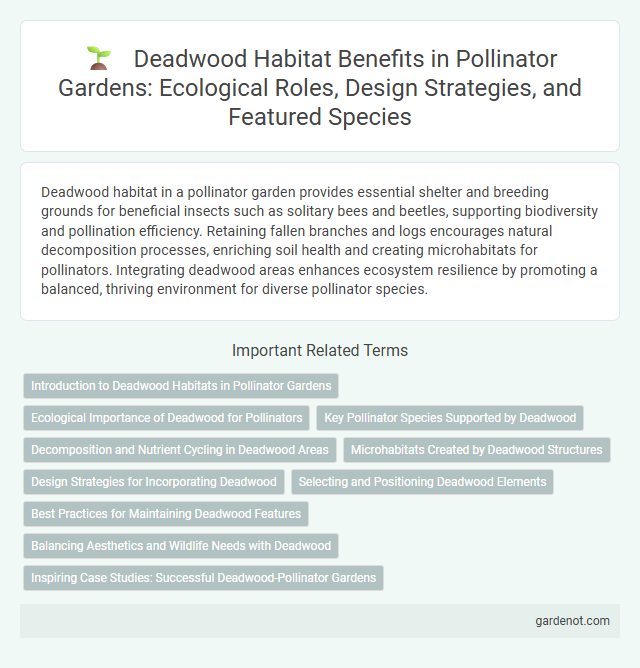Deadwood habitat in a pollinator garden provides essential shelter and breeding grounds for beneficial insects such as solitary bees and beetles, supporting biodiversity and pollination efficiency. Retaining fallen branches and logs encourages natural decomposition processes, enriching soil health and creating microhabitats for pollinators. Integrating deadwood areas enhances ecosystem resilience by promoting a balanced, thriving environment for diverse pollinator species.
Introduction to Deadwood Habitats in Pollinator Gardens
Deadwood habitats in pollinator gardens provide essential shelter and breeding sites for beneficial insects such as solitary bees, beetles, and other pollinators. These decomposing logs and branches support biodiversity by offering a natural refuge and maintaining ecosystem balance. Incorporating deadwood fosters a thriving habitat that enhances pollination and promotes healthy garden environments.
Ecological Importance of Deadwood for Pollinators
Deadwood provides essential habitats for a variety of pollinators, including native bees and beetles, by offering nesting sites and shelter critical for their life cycles. Its ecological role supports biodiversity by sustaining populations of pollinators that contribute to the pollination of numerous plant species within the garden ecosystem. Maintaining deadwood in pollinator gardens enhances ecosystem resilience and promotes natural pest control through pollinator diversity.
Key Pollinator Species Supported by Deadwood
Deadwood supports key pollinator species such as solitary bees, wasps, and beetles, which rely on its cavities and decaying wood for nesting and shelter. Native solitary bees, including mason and leafcutter bees, use deadwood tunnels to lay eggs, ensuring population stability and pollination efficiency. Beetles that develop in deadwood contribute to nutrient cycling while indirectly supporting pollinator diversity and ecosystem health.
Decomposition and Nutrient Cycling in Deadwood Areas
Deadwood habitats play a crucial role in pollinator gardens by facilitating decomposition and nutrient cycling, which enrich the soil with essential minerals. Fungi, bacteria, and insects break down deadwood, releasing nutrients that support the growth of pollinator-friendly plants like native wildflowers. This natural process enhances soil fertility and promotes a sustainable ecosystem for bees, butterflies, and other pollinators.
Microhabitats Created by Deadwood Structures
Deadwood structures in pollinator gardens create essential microhabitats that support diverse insect species, including solitary bees and beetles. These decaying wood environments provide shelter, nesting sites, and food resources, enhancing biodiversity and ecosystem resilience. Incorporating deadwood habitat fosters natural pollinator populations by maintaining critical life cycle functions within the garden ecosystem.
Design Strategies for Incorporating Deadwood
Incorporating deadwood into pollinator garden designs enhances habitat diversity by providing essential nesting and overwintering sites for native bees, beetles, and other beneficial insects. Design strategies include arranging logs, branches, and snags in varied orientations and decompositional stages to support a wide range of species and microhabitats. Positioning deadwood in sun-exposed areas with partial shade helps maintain moisture balance and encourages fungal growth, which further attracts decomposer and pollinator communities.
Selecting and Positioning Deadwood Elements
Selecting deadwood elements such as logs, branches, and stumps that retain moisture and have varying degrees of decay enhances habitat suitability for pollinators like solitary bees and beetles. Positioning these deadwood pieces in shaded, sheltered areas with proximity to native flowering plants increases their effectiveness as shelter and nesting sites. Ensuring a diversity of wood types and orientations supports a wider range of pollinator species by mimicking natural forest conditions.
Best Practices for Maintaining Deadwood Features
Maintaining deadwood features in pollinator gardens involves leaving fallen branches and logs undisturbed to support native bee nesting and habitat for beneficial insects. Regularly monitor for signs of decay or infestation while preserving structural integrity to maximize ecological benefits. Avoiding removal of deadwood in late spring and summer protects emerging pollinator populations and promotes biodiversity.
Balancing Aesthetics and Wildlife Needs with Deadwood
Deadwood habitat plays a crucial role in pollinator gardens by providing essential nesting and foraging sites for native pollinators such as solitary bees and beetles. Incorporating strategically placed deadwood preserves biodiversity while maintaining a visually appealing garden design through natural textures and rustic elements. Balancing aesthetics with the ecological functions of deadwood supports pollinator health and enhances the overall sustainability of the garden ecosystem.
Inspiring Case Studies: Successful Deadwood-Pollinator Gardens
Successful deadwood-pollinator gardens, such as the Xerces Society's Native Plant Garden in Oregon, demonstrate how incorporating logs and snags supports native bee nesting and increases pollinator diversity. Pennsylvania's Stroud Water Research Center transformed fallen trees into habitats that sustain solitary wasps and beetles crucial for ecosystem balance. These case studies highlight the essential role of decaying wood in creating thriving, sustainable pollinator habitats with enhanced biodiversity.
Deadwood habitat Infographic

 gardenot.com
gardenot.com